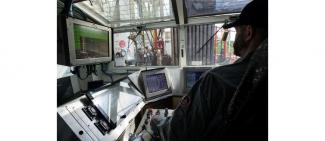NETL joined West Virginia University and Ohio State University in 2014 to create the Marcellus Shale Energy and Environmental Laboratory (MSEEL) — a test well project intended to improve natural gas production efficiency and minimize environmental impacts at hydraulic fracturing sites throughout the Marcellus Shale region. Five years and a long list of accomplishments later, MSEEL continues to yield new knowledge with an additional test well that is helping researchers discover and disseminate technical knowledge that will assist the nation in maintaining its energy security and improving the competitiveness of the oil and gas industry, all while protecting the environment.
An oil and gas “play” is the focus area of a natural gas or oil formation. The Marcellus Shale play is a large area that encompasses 104,000 square miles and stretches across Pennsylvania and West Virginia, and into eastern Ohio and western New York. It is the largest source of natural gas in the United States. The natural gas of the Marcellus Shale play is trapped in low-permeability shale and requires hydraulic fracturing — a stimulation technique in which rock is fractured by an injection of “fracking fluid” into a wellbore to create cracks in the deep-rock formations — to allow the gas to flow to the surface via a well bore.
MSEEL is funded by the U.S. Department of Energy with NETL providing project management and technical oversight. The project provides an unbiased view of the environmental impact of the drilling and stimulation processes. Earlier MSEEL efforts focused on a dedicated field site and laboratory at the Northeast Natural Energy (NNE) production site in Morgantown, West Virginia, and produced reams of useful research information that increased reserves at the Morgantown MSEEL site by 20% and produced wellsite best practices that were incorporated into NNE operations.
MSEEL work included the creation of a dedicated scientific observation well to collect detailed subsurface data with seismic array instruments to monitor stimulation events in two wells and collection of 147 core drillings.
Just some of the research progress at the heart of MSEEL research included:
- Use of data acquisition and modeling approaches for reservoir-scale simulations.
- A more detailed understanding of subsurface rock properties, faults and fracture systems.
- Integration of geochemical and microbiological studies to better understand the effects of fluid and rock interactions over time.
- Confirmation that synthetic drilling mud that is cleaner and more environmentally friendly to dispose of than traditional mud while improving drilling performance.
According to NETL’s John Duda, MSEEL’s current research is based on earlier successes and is occurring at a new wellsite near Core, West Virginia.
“The current R&D is geared toward cost-effectively improving gas recovery from horizontal drilling and hydraulic fracturing in the region,” he explained. “The initial efforts advanced hydraulic fracture stimulation techniques that NETL researchers pioneered years ago. A key objective of the field test is to demonstrate more cost-effective techniques for the development of advanced completion strategies that can be applied to other areas of the Marcellus shale play to improve overall resource recovery efficiency.”
One major difference from when we initiated the research to today’s efforts is the improvement in technologies that are now available to facilitate the new research.
“For example, aided by advanced numerical modeling developed by WVU, the project team will calibrate results from a large array of data acquired via less-expensive, new tools at the Core site,” Duda said.
Additionally, to help attain the goal of defining what a fracture network looks like, very sensitive fiber optics are being used that can provide a determination of true fracture dimensions and geometries. That data will be used to maximize reservoir contact while, at the same time, reducing the overall use of sand and water in the fracturing process.
According to Sagerider, the company that deployed the fiber optics in the most recent well, the project is one of the most extensive ever performed. Duda said the fiber optics will allow NETL, in collaboration with industry, to acquire copious data to maximize resource recovery efficiency.
MSEEL’s is making material impacts to the oil and gas industry.
“If MSEEL can prove that these and other technologies under consideration work and lead to improved well results, lessons learned from the project can lead to more efficient and effective resource recovery in the region and possibly throughout other U.S. shale plays, thereby improving the nation’s energy security and industrial competitiveness,” Duda explained.




